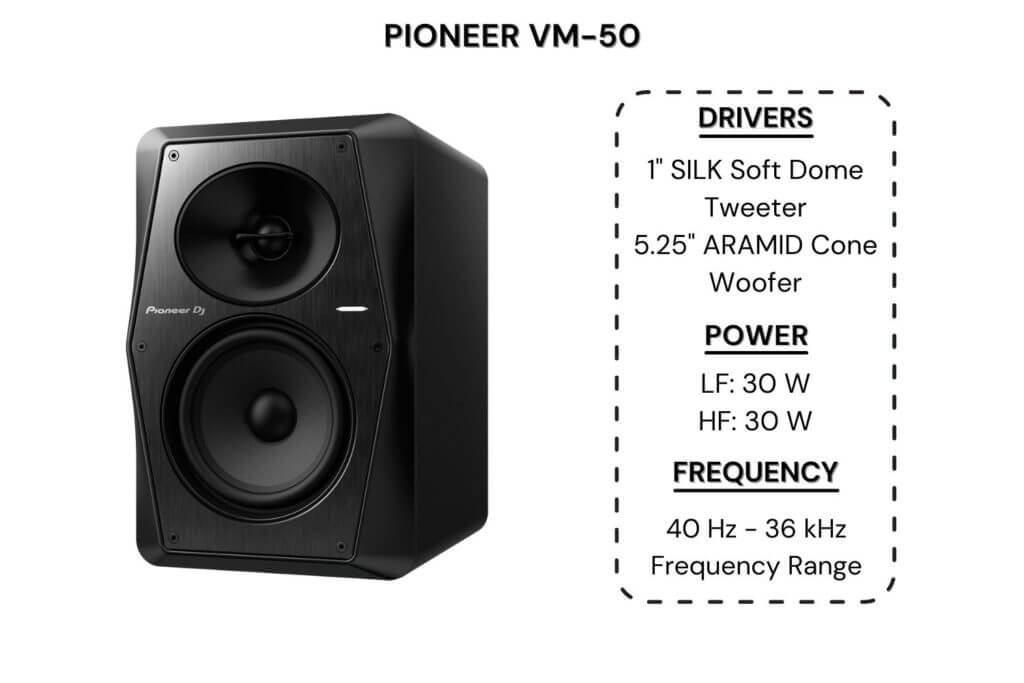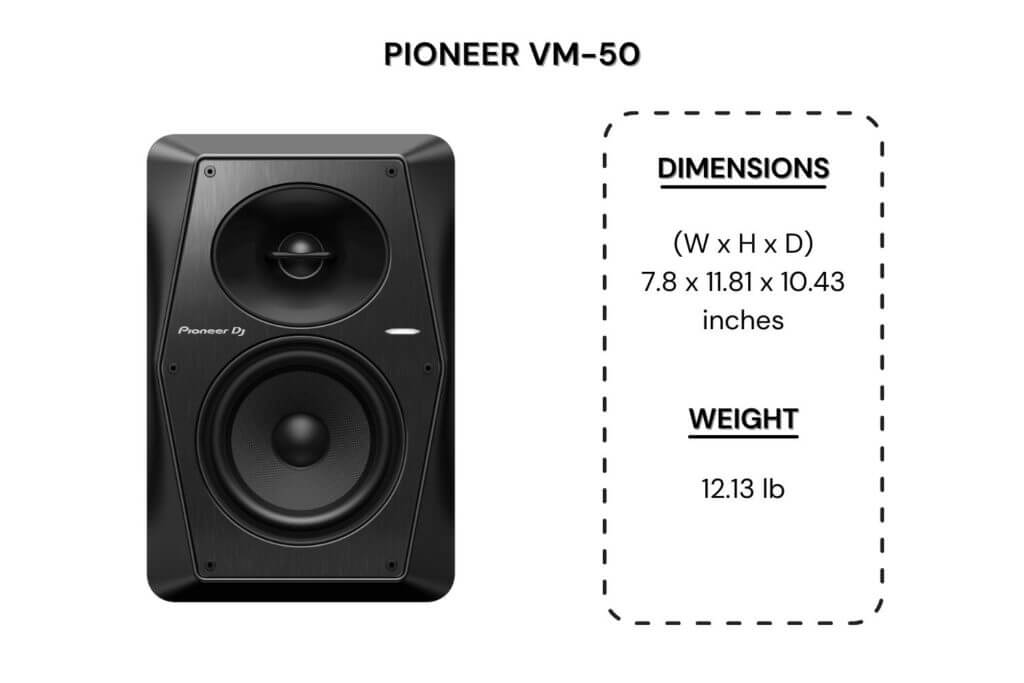If there’s one brand that is synonymous with the DJ and DJing world, it’s Pioneer DJ. If you were to ask virtually any DJ or club/festival manager, odds are they would either personally have or be well associated with at least one Pioneer DJ-brand product.
These are the same guys that are most well known for their various controllers and DJ devices, really leading the charge in bringing DJing into the mainstream.
Well, this DJ tech giant has decided to expand its reach yet again, this time stepping into the world of DJ speakers.
Recently unveiling their new Pioneer DJ VM-50, Pioneer hopes to essentially corner the music and DJ turntable market entirely, giving artists every piece of the DJing puzzle.
And, while that is certainly an impressive goal, the ultimate question is, “can they do it?”.
Here, we’ll check out what the DJ VM-50 has to offer, whether it and the rest of the VM series have what it takes to stand out in an otherwise crowded market of top-tier studio monitors, and if they truly can become a DJ’s one-stop-shop.
Are the Pioneer DJ VM-50 any good?
They are super easy to set up and are a great-sounding set of monitor active speakers. The VM series will definitely please most users, especially at this price point. It’s a vast improvement over Pioneer DJ’s older speakers and they look as good as it sounds.

First Impressions – The Physical Build
Immediately, fresh out of the box, the first thing that got me was the VM-50’s design. We’ll certainly have a chance to go over it later on in the review, but I had to take a moment to go over it here.
First and foremost, it just looks cool! I’m a pretty big fan of well-designed speakers and am always on the lookout for them. As such, the moment I saw what this had going for it, I instantly became a fan. Again, we’ll go over the design in more detail later.
Suffice it to say, it is way more interesting than a normal speaker.
Outside of aesthetics, the VM-50 is very clearly made from some impressive materials. Despite only weighing around 12 pounds, the speaker feels incredibly durable as well as long-lasting.
One interesting aspect of the VM-50 is its rear-facing ports.
While many of the more popular monitors will have front-facing ports, Pioneer has instead opted to have them in the back. These are located just above the control panels and connection ports.
This is used to help improve the active speaker’s low-end bass, giving it a stronger and more punchy-free form.
Pioneer calls it the Vortex Bass Accelerator and states that it essentially allows the speaker’s bass from dealing with any unintended distortions or vibrations.
The only issue is that you’ll need to be careful where you put the speakers, as putting them too close to a wall can result in excessive boominess.
The Specs
In terms of its makeup, the Pioneer DJ VM-50 is a Class D amplifier studio monitor speaker with a frequency response ranging between 40Hz on the low end and 36kHz at the higher ranges.
The VM-50 produces around 60 watts of power along with a bi-amped setup, with both the woofer and the tweeter individually able to put out 30 watts.
The speaker has a maximum SPL of around 107dB when pushed to its limits, though you’ll want to only take it to those extremes for very short periods to prevent any burnout or sound quality degradation.
Physically, the VM-50 is the smallest of the VM series, rocking a size of just around 12 pounds. It has a length of around 12 inches, a width of 8 inches, and a depth of around 10 inches.
This is far and away from smaller than either of its bigger brothers, the VM-70 and the VM-80, both weighing in at 17 pounds and 22 pounds respectively.
Spec Breakdown
- Length: 12 inches (305mm)
- Width: 8 inches (203mm)
- Depth: 10 inches (254mm)
- Weight: 12 lbs. (5.4kg)
- Woofer Size: 5.25 inches
- Tweeter Size: 1 inch
- Max SPL: dB
- Frequency Range: 40Hz – 36kHz
The Design
Now getting into the speaker’s design, the first thing you’ll notice is that the VM-50 looks very different from how most other studio monitors appear.
While it does share some of the same core aspects (box-like design, woofer and tweeter speakers, backports, etc.) those are the basic tenants that pretty much every studio monitor or speaker will have. They are also the least important factors when it comes to a speaker’s overall design.
What starts getting more interesting is the way Pioneer DJ has managed to play around with these core aspects and change them in a way that makes the VM-50 more or less unique from the rest of the competition.
For one, it has a more oblong, hexagonal front rather than the more textbook flat square design.
Not only is the shape of the speaker immediately different from anything else, but it also sports a 4mm-thick front baffle plate. This both helps to further give the speaker plate a bit of unique characterization while also helping to suppress any resonance and vibrations produced.
Finally, the VM-50 further presents itself as a unique option, design-wise, by way of its soft dome tweeter and Aramid fiber woofer cone both being equal in width.
Generally, as the woofer is several inches larger, most active speakers will opt for a much larger woofer width, with the tweeter generally being a good bit smaller.
Not so with the VM-50.
Instead, Pioneer has argued that, by making them equal in width, the speaker can enable a smoother frequency crossover while also producing a much more natural sound.
In addition to the standard all-black, you can also get the VM-50 in white, granting it that small bit of additional unique design options over so many other studio monitors out there.

Taking A Deeper Look – Features & Sound Quality
Since we’ve had a chance to check out the VM-50’s physical build and specifications, let’s now take a look at what the active speakers have going in terms of their sound quality as well as whatever features are included.
Sound Quality
With Pioneer’s VM-50 being quite impressive in terms of its physical build, I was interested in seeing how it would fare in regards to its sound quality.
After all, no matter how good a speaker’s design is if the sound is bad, you’ve pretty much just purchased a good-looking box.
Thankfully, Pioneer seems to know what they’re doing.
While they could have just done “good enough”, resting on their name and reputation to put out a decent speaker, it seems they’ve gone above and beyond to put something together that is legitimately a force to be reckoned with.
What It Gets Right
From the start, the VM-5o seems interested in putting together an impressive setup, starting with its “sweet spot”.
Because the “sweet spot” for studio monitors is very important to optimize the sound quality of all three frequencies, making sure your speakers get it right is pretty much as close to a requirement as there is if you want to consider the speakers as being “good”.
The VM-50 masters this, setting up a near-perfect triangle of sound frequencies.
The highs are incredibly sharp while never spiking, instead of coming across as super clear and refined. Meanwhile, the mid-range frequencies hit as super crisp and detailed while also quite welcoming.
In addition, the speaker has managed to produce an incredibly flat, pure sound that isn’t colored or muddied in any way, allowing you to digest and engage with the music itself.
What It Doesn’t
Of course, as I said, the VM-50 gets it nearly perfect. While not quite knocking it out of the park, Pioneer’s smallest speaker stumbles where so many other smaller speakers stumble. The low-end bass.
Now, for what it’s worth, not only is this somewhat expected when you consider the woofer size, but with all things considered, the VM-50 gets more right with its low-end frequencies than it gets wrong.
Still, even if you’ve got the more bass-heavy EQ settings turned on, you’re not going to have a particularly meaty bass, especially when compared to the larger monitors out there.
That said, while not punching as hard as you might like, the VM-50 does still have a pretty clean low-end that is, all in all, a great experience to listen to.
If you want to crank it to the next level – if, for example, you’re playing in a small venue or just want to get the blood pumping – you can always consider bringing in a supplemental subwoofer to help bridge the gap.

Features Offered
Connection Options
The VM-50 sports a few audio inputs to play with. In addition to the standard three-pronged power cable, the speaker comes with a balanced combo input that works for either the TRS or the XLR jack.
The cable port is 1/4th-inch and comes with an additional unbalanced RCA input port. This gives the VM-50 a considerable leg up on even most of the higher-end speakers, which often only either have an RCA or a TRS/XLR port available.
Tuning Options
Now, where the VM-50 shines through as a top-tier speaker and puts the Pioneer brand as a solid contender in the studio monitor space, is its tuning options. Generally, tuning can be hit or miss with most speakers out there.
While some have super extensive options, there are just as many that don’t have many options at all. Tuning options essentially help a speaker play at its best even when not sitting in the most optimal setting.
Not only that, but most tuning options also include several EQ settings that are used to further improve a person’s overall listening experience.
Thankfully, while Pioneer’s VM-50 isn’t replete with dozens upon dozens of tuning features, it does have more than enough to help any person properly set up their space for the most optimal sounds.
For one, the VM-50 has “Low EQ settings”.
These, as the name implies, are meant for the lower-end frequencies while also working to increase the overall bass for the speakers. They include “Room 1”, “Flat”, “Room 2”, and “Club Bass”.
Club Bass, in particular, bumps things up to 50Hz.
On the other hand, there are also the “High EQ settings”. These, conversely, move to affect the higher-end frequency settings and contain very similar presets as the Low EQ settings.
The one major difference is the last setting, which is changed from “Club Bass” to “Bright Treble”. Instead of lowering things to the 50Hz levels, Bright Treble instead raises them into the 4KHz and 8kHz areas.
There is also the aforementioned “Flat setting”. This won’t get things perfectly flat as it would in other settings. However, you can get pretty close.
While purists and musical aficionados may find the color slightly off-putting, for the majority of casual listeners, it should be pretty reasonable to the senses.
Final Thoughts – Is it Worth Your Time?
When going over what Pioneer had put together with the VM-50, I was legitimately shocked. Again, while the company had certainly made a name for themselves in the DJing world, they had reasonably kept out of the speaker and studio monitor space.
As such, while I wasn’t expecting a train wreck by any means, I also wasn’t expecting a near-home run either.
No, the Pioneer DJ VM-50 is not a home run, nor is it a disaster of a speaker.
However, if I had to answer which one it was closer to, I’d say it was much more impressive as a speaker than really anyone would have initially thought. It’s got an impressive build and design with amazing sound quality and numerous features.
There’s very little this thing does that one could consider “wrong”, with even those hiccups not being nearly as bad as one would expect a company to make this early in their career.
So, to answer the question, “Is the Pioneer DJ VM-50 worth your time?”
Without question or hesitation, I say it is worth your time.
Not only is it a great option for those that are Pioneer fans, but it’s also a super impressive option for those just starting out and in need of an entry-level studio monitor.
From its design and build to how clear all of its frequencies are, this is an incredible option, even more so when you consider just how affordable it is.
Simply put, while those that expect to be in front of huge groups may find this speaker a bit lacking (possibly finding the VM-60 or VM-70 more agreeable) it is a great option for anyone that needs something awesome to start with (or needs a backup monitor).

Pros & Cons
Pros
- Playback Is Very Accurate & Tight
- Has A Compelling And Interesting Design
- Very Competitively Priced
- DSP Helps When Dealing With Room Shapes & Sizes
Cons
- Bass Could Be Heavier
- Higher Volumes Have Some Distortion
Pioneer DJ VM-50: The Verdict
Pioneer came with one specific purpose when bringing out the DJ VM series. That was to prove that they could take all of what they’d learned about DJ music and controllers and put that into a high-quality speaker setup. And sure enough, not only did they do it, but they made it look easy.
Is the VM-50 in and of itself going to take over the monitor space to quite the same degree as their DJ controllers have?
Maybe or maybe not.
The speaker isn’t perfect and it’s clear that this is just a “first trial” of sorts.
However, what’s worth considering is how the following generations go. If they were able to do this well on what’s their first try, Pioneer’s studio monitor space may just be something really scary in a year or two.




